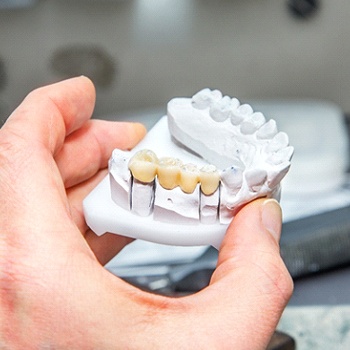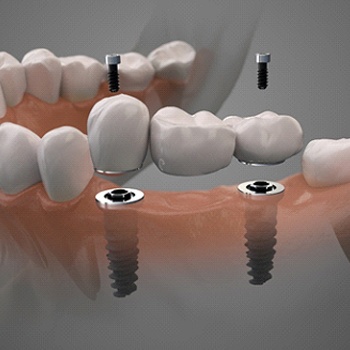
Dental Bridges – Allen, TX
Replace Your Teeth Without Breaking the Bank
Tooth loss is a common issue that affects millions of Americans across the country. Approximately 178 million people are missing at least one of their teeth for one reason or another. Fortunately, just because you have lost a tooth doesn’t mean that you need to go the rest of your life with an unsightly gap in your smile. At Allen Smile Design, Dr. Tonie C. Lewis offers high-quality dental bridges in Allen to restore smiles affected by tooth loss. If you have gaps in your smile, give us a call to get started with an initial consultation.

Why Choose Allen Smile Design for Dental Bridges?
- Skilled Dentist with 15+ Years of Experience
- Made from High-Quality, Long-Lasting Materials
- In-Network with Numerous Dental Insurance Plans
What is a Dental Bridge?

A dental bridge is a restoration that’s used to replace one or several consecutive missing teeth. This can be anywhere from one to four missing teeth in a row. The bridge is composed of two crowns and a number of replacement teeth known at “pontics.” The crowns are anchored on the adjacent teeth or implants, depending on the type of bridge you opt for. Bridges can be made out of a variety of different materials, but porcelain is usually the best choice for a strong, natural-looking restoration.
Types of Dental Bridges

If Dr. Lewis determines that you make a good candidate for a dental bridge, you have two different types that you could end up with. Here is what each one consists of:
Traditional Bridge
If you have healthy teeth on both sides of the gap that needs to be filled it, a traditional bridge is likely the ideal option. The teeth that support crowns are known as “abutment teeth,” and they need to be altered slightly for the bridge to fit properly. This type of restoration can be placed in just a few visits and typically costs less than its alternative.
Implant Bridge
Dental implant bridges are used when there are three or more missing teeth in a row. Instead of being placed over abutment teeth, the crowns are placed on titanium, screw-like implants that are placed directly into the jawbone via a surgical procedure. They fuse with the jawbone over time and act as artificial tooth roots. On average, implant bridges last longer than traditional bridges and help to prevent future jawbone deterioration as a result of tooth loss.
The Benefits of Dental Bridges

A bridge is a relatively simple and cost-effective option for replacing missing teeth. In addition to providing additional strength and stability for chewing and speaking, they help to maintain the shape of your face. They also keep your natural teeth from shifting out of place and leading to misalignment issues last on.
Dental Bridges FAQs
Can You Take a Dental Bridge Out?
Your dental bridge is designed to be a permanent fixture. The idea is to provide you with a reliable and sturdy restoration that stays in place while you eat and talk, so only a dental professional can remove or replace it safely. This helps ensure your dental bridge feels as comfortable and natural as possible!
How Long Should a Dental Bridge Last?
With proper care, you can expect your dental bridge to last for up to 15 years – though implant bridges typically last longer. To help your restoration stand the test of time, follow these do’s, don’ts, and limitations:
- Do brush your teeth (and bridge) twice daily
- Do floss between your pearly whites every day
- Do visit us every six months for a professional dental cleaning
- Don’t bite your nails
- Don’t use your teeth as tools
- Don’t crunch down on ice
- Limit tobacco products
- Limit hard candy and other tough substances
- Limit sugar intake and acidic treats
Dental bridges are made from durable inorganic materials, but they can still break, wear down, and lose stability just like real teeth. It’s important to keep these tips in mind!
Can Dental Bridges Be Whitened?
Unfortunately, teeth whitening treatments specifically target tooth enamel, and don’t work well on non-porous surfaces. Enamel has pores that allow the whitening agents to “settle in” and remove stains, whereas dental bridges do not. However, this also means that your dental bridge won’t discolor as easily as your natural teeth!
If you’re concerned about the brightness of your smile, we recommend whitening your teeth before receiving your restoration, then preserving your natural teeth’s new shade as much as possible with consistent oral hygiene and by avoiding richly pigmented treats (such as berries, wine, fruit juice, etc.). That way, your pearly whites and dental bridge will appear more seamless for longer.
Can Dental Bridges Get Cavities?
Technically, the restoration itself can’t develop cavities. The bacteria that eat away at your enamel simply don’t have a taste for inorganic dental bridges. However, they do like to feast on the teeth that support your pontics from underneath crowns! Your gums are still at risk for developing gum disease, too, if you let bacteria run wild in your mouth.
This is why good and consistent oral hygiene at home is so important. Twice daily brushing helps scrub away bacteria before it can form into more stubborn plaque or build up to “critical mass,” and daily flossing takes care of whatever might be hiding between your teeth. We’ll be sure to advise you on how best to clean and take care of your dental bridge, but don’t hesitate to contact us for more oral hygiene recommendations!